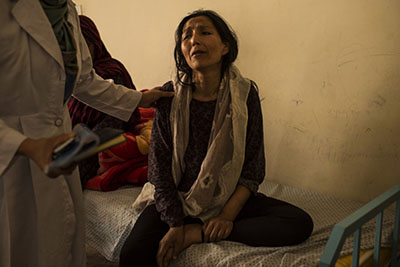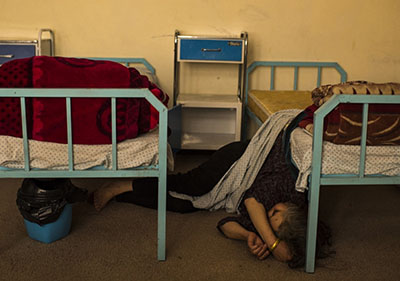By Saqib Fikree
The question of drugs is one that will determine Afghanistan’s future.
While the talks between the United States and the Taliban continue, one key factor contributing to Afghanistan’s instability is not discussed — opium cultivation and drug trafficking. Afghanistan is the top producer of opium in the world, generating more than 90% of the world’s supply. Opium not only funds the Taliban and other terrorist groups, but it has also led to a “silent tsunami” of addiction across the country.
Afghanistan emerged as a significant opium producer in the mid-1950s, after neighboring Iran made its production illegal. However, it was in the mid-1970s, when political instability and a prolonged drought disrupted the flow of drugs from Southeast Asia’s Golden Triangle, that Afghanistan and Pakistan began to supply large quantities of opiates to Europe and North America. The Soviet Invasion of Afghanistan in 1979, and the conflict that followed, boosted the cultivation of opium amid instability and the breakdown of the rule of law.
Attempts by the Afghan government and the international community to upend the Taliban’s influence and to create a viable legal economy have been consistently undermined by the illicit cash generated by the opium trade, which has unbalanced the country’s economy. The export value of Afghan opium was between $4.1 billion to $6.6 billion in 2017, with a quarter being earned by opium farmers, and the rest going to the Taliban, government officials, warlords and drug traffickers. The size of the opium economy far exceeded the value of Afghanistan’s exports of legal goods and services in 2016.
Cash Crop
The Taliban banned the cultivation of opium in 2001, shortly before being ousted by the US-led NATO coalition. However, after 2005, the Taliban began to regroup, and encouraged opium production to finance its insurgency by forcing locals to grow opium and punishing those who refused. Besides, major opium traffickers annually pay vast amounts to the Taliban in exchange for safe transport routes secured by the group.

A woman recently admitted to the National Center for the Treatment of Addiction for Women and Children in Kabul is calmed by nurses and doctors after collapsing in a corridor during withdrawal from her opium addiction. She was brought to the facility by her 16-year-old daughter, who insisted she stay there until she recovered, saying, “She is our mother, but she has ruined our family.” (Photo: Andrew Quilty/For The Washington Post)
The Taliban uses the money it collects from the opium trade to pay fighters’ salaries, buy fuel, food, weapons and explosives. Based on some reports, around 40% of the Taliban’s funding comes from opium production, while the rest of its expenditure is borne by foreign patrons and tax collections. The group’s annual income from the opium trade was estimated to be $400 million in 2011, but it is believed to have significantly increased in recent years.
The Taliban collect two types of taxes from opium businesses: a transportation tax from drug trafficking and a 10% tax from opium cultivation. In exchange, the group provides security for the drug convoys and carries out attacks on government institutions like checkpoints in order to allow drug convoys to pass. The group has also launched attacks on government forces to safeguard drug labs and factories.
Opium traders fund madrassas in neighboring Pakistan, where Taliban fighters are trained, and hotels where they can recuperate in. Traffickers also pay the medical expenses for injured Taliban fighters, and at least one primary dealer runs his private health clinic in Quetta, Pakistan, which is reportedly filled at any given time by wounded fighters.
The Taliban mainly pursued two objectives by allowing the opium trade to flourish. Firstly, it is the most accessible financial source that helps the group to fund its fighters and keep its war machine intact. Secondly, the group tried to win over the impoverished locals and secure their support. To some extent this tactic has been successful, as poor farmers are dependent on the profits from opium cultivation for their livelihoods. Thus, the eradication of opium fields by the international community and the Afghan government has made the farmers lean toward the Taliban. Based on this mutual interest, locals provide shelter and food to the Taliban, and refrain from sharing information with the security forces. In interviews with Taliban fighters, journalist Graeme Smith found that a large part joined the insurgency because the international troops had destroyed their poppy fields.
Ideology or Profit?
As Paul Collier points out, rebellion is an industry that generates profits from looting, and insurgents are often indistinguishable from bandits and pirates. If one considers the scale of opium cultivation and trade, it becomes apparent that the nature of the conflict in Afghanistan has changed from one based on ideology to one based on profit.

A drug-addicted woman who was admitted the day before sleeps on the floor where she fell in the detoxification ward last month at the National Center for the Treatment of Addiction for Women and Children in Kabul. The center, which opened several months ago, is one of the few such facilities for women in Afghanistan. (Photo: Andrew Quilty/For The Washington Post)
Although the Taliban presents itself as being comprised of pious Muslims and true defenders of Islamic values intent on establishing a pure Islamic state, in reality it ignores the clear Quranic rulings that explicitly forbid Muslims from cultivating and taking drugs. The justification for the mostly illiterate locals comes from declaring that opium is permissible because kafirs — unbelievers — in the West consume it, not Afghans. Unsurprisingly, however, the availability of drugs has flooded the domestic market. Consequently, Afghanistan has one of the highest numbers of drug addicts in the world at around 3 million, who make up 10% of the total population.
Conflict and opium are mutually related: Geographically, poppy cultivation is highly concentrated in insecure and destabilized areas in the south, where the Taliban wields more influence. According to the United Nations Organization for Drugs and Crime report, by 2008, about 98% of Afghanistan’s poppy crop was grown in six southern and southwestern provinces, namely Helmand, Farah, Uruzgan, Kandahar, Nimroz and Zabul.
Following the death of Mullah Mohammad Omar, the founding leader of the Taliban, Mullah Mohammad Rasool, a prominent commander, did not accept Akhtar Mansour as successor. The two factions fought for the control of drug trafficking routes. This intra-Taliban power struggle suggests that the group’s ideological identity is diminishing. A survey conducted by the United States Institute of Peace confirms that more than 80% of those surveyed believed that Taliban commanders in the south fight for profit rather than ideology.
Losing the War on Opium
Until now, the international community undertook two different approaches to disrupting the opium trade. First, it started a “war on opium,” in which it bombed poppy fields, the US alone pouring around $1.5m per day into fighting opium production since 2001 — to little effect. It also produced unwanted outcomes, as the tactic forced farmers to join the Taliban in the absence of any other alternative means of income in areas where the government failed to establish itself.
The international community and the Afghan government also tried to encourage the cultivation of alternative crops and provided development funds to the provinces with high rates of opium production. For many farmers in Afghanistan, growing poppies offers a reliable source of income that far exceeds the money brought in by other crops. But so far, only in Herat province did saffron — the world’s most expensive spice — replace opium production. As far as the rest of Afghanistan is concerned, saffron cannot be a reliable alternative, as not all regions are equally suited to grow it. The initiative also failed as officials misused or pocketed funds allocated to subsidize alternative crops.
Afghanistan’s former president, Hamid Karzai, is right in his claim that the question of drugs is one that will determine the country’s future. If it fails to uproot opium production, Afghanistan will fail as a state. The strategy for eradicating drugs in Afghanistan should be more comprehensive. For that, the Afghan government and its international backers must deal with all the players involved. A policy only focused on destroying opium fields without controlling the borders and ensuring the efficiency of the funds provided for alternative crops will not bear any fruit. Furthermore, it should involve the regional states in the fight against terrorism and drug trafficking, because Afghanistan’s fight against drugs has regional and global implications when it comes to eradicating terrorism and cross-border non-state actors.
This is why it is unwise to ignore the opium issue during the ongoing peace negotiations with the Taliban. Talks mainly revolve around a ceasefire, the withdrawal of NATO forces and seeking a guarantee from the Taliban not to allow other terrorist organizations to operate in Afghanistan. These developments are encouraging. But peace negotiations are unlikely to achieve Afghanistan’s main national security objective of eliminating financial lifelines for terrorist organizations if talks fail to directly address the country’s opium problem.



